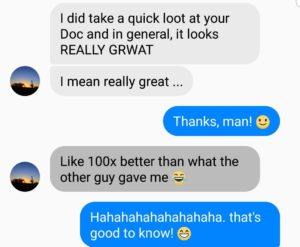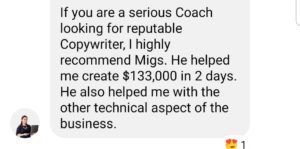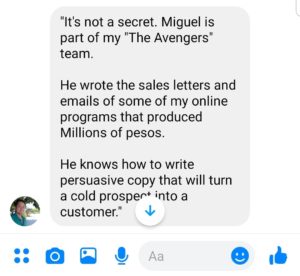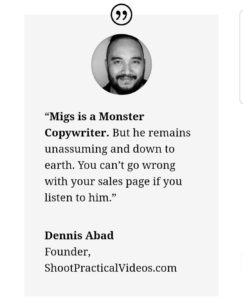“80% of the research was already done for you.”
When I heard this, I was so relieved. I didn’t have to put THAT much effort to write high-converting sales copy. My competitors already did ALL the heavy-lifting for me.
The highest converting emails, sales letters, and VSLs (those that make $1M in net sales) are obviously well-researched. Most of the time, there’s a team of highly dedicated researchers behind each campaign. I even heard copywriters from Natural Health Sherpa would read 200-pages of pure research before writing any copy. To me, that’s amazing
Now, if you’re a solo-preneur (and you don’t have the budget to build a research team yet), you need to do the research yourself. The good news is you don’t have to start from scratch.
What’ I’m going to show you is a Copywriting Research Process that helps me find 80% of the data I need to write high-converting email sequences, sales letters, and VSL scripts. The process is simple: all you need to do now is study your competitors’ sales messages, break them down, copy what they’re doing right, put your own spin to it, and then use it in your promotions.
Contents
The Three-Step Copywriting Research Method
This is a Three-Step process that has worked time and time again. I recently used this research process to help a client make $21,648 in 10 days. The entire process was inspired by what I learned from Copy Monk and Copy Hour. If you see familiar elements, that’s probably because you’ve seen it on those sites.
Now, I divided the research process into Three Phases. If you don’t know yet, sales copy is not the most important element in a promotion. According to Mark Ford (the person behind the meteoric rise of Agora), two things come before copy.
Here they are, in order of importance:
- The List (customer)
- Your Offer (product)
- Copy (sales letters, emails, VSLs)
Your customer always comes first. Once you identify your target customer, you need to create offers your customer wants.
Since I’m a copywriter, the client’s needs come first. So whenever I start my research, first start with the product. I want to know the offer inside-and-out so I can effectively sell it.

Phase I – Product
- Hop on discovery call with the client.
- Write down what the product is and what it’s not. Who is it for? Who is it NOT for?
- Do they have a bonus? Does the bonus compliment the product?
- Where is the traffic coming from? (Email list, FB ads, Google Ads, affiliates, JV partners, etc.)
- Do they have a Unique Selling Proposition?
- Develop the One Big Idea. (Remember you’re selling a concept. Not a product or service.)
- Write your best guess for Market Sophistication and Awareness Level of prospects
- Write down desired medium (emails, sales letters, VSLs, banner ads)
- Ask clients for existing marketing materials and existing market research (if they have them)
- Write down product’s features and benefits in bullets
- Write down product’s “Dimensionalized” Benefits and its 5-foot & 5-mile benefits.
Phase II – Market Research
- List the top 15 competitors in your niche
- Collect their ads, sign up for their newsletters, follow them on social media, go through their funnel, find their banner ads — find ALL their marketing materials. The more, the better.
- Eliminate the competitors that don’t serve you well. For example, if you’re targeting 40-50 year old, eliminate competitors that target 25-35 year olds.
- You should have a list of at least 5 direct competitors and 5 indirect competitors. Direct competitors are businesses that sell to the same target market using the same medium as yours. Indirect competitors are businesses that sell different products to the same target market.
- Find and begin consuming your direct competitors’ sales materials. I use Copy Monk’s “Centerline Method” to break down down their sales messages.
- Find and begin consuming your indirect competitors’ sales materials. Again, I still use Copy Monk’s “Centerline Method” to break down their sales messages.
- Write competitors’ (direct and indirect) headlines and subheadlines down in one place.
- Read through your breakdowns and go through the headlines and subheadlines.
- Bonus Step: while going through your notes, scratch your chin and go “hmmmmm…” (This is what Gary Halbert tells his son to do in the Boron Letters).
Phase III – Copywriting
- Create Personas, determine their Worldview and complete your Empathy Map
- List down the top 5 pains and top 5 gains the customer will get once he/she purchases the product
- Determine your Marketing Story.
- What’s your One Dominant Emotion?
- What is the transformation they will go through?
- What is the #1 thing they should believe first before they buy?
- List down the terms, phrases, and languages they often use in their day-to-day life.
- List down the 10 “Power Words” and 10 “Emotional Words” you can use in your sales copy
- Collect all the proof you can get: anecdotes, testimonials, social proof, scientific research, etc.
- Write your sales copy:
- *Word Vomit* the first draft in 2-3 days. Ask feedback from other copywriters.
- Edit copy using Bond Halbert’s book as a reference (highly recommended)
- See if copy completely satisfies the Hierarchy of Copy by CopyGrad.
- Edit again. And then submit to client
- Revise until copy converts.
I know, this looks tiring. And it is. But research is one of those things that you only do once. If you do them right, you won’t have to do them ever again. Plus, the backbone of everyone successful email, VSL, or sales letter has always (and always will be) research.
Now, I mentioned earlier that this research is only 80% of data you need.
What’s the other 20%? Interviews.

You need to speak to your target market. Ask them what they want. Schedule Skype video calls or simple Facebook messenger chats. You’d be surprised what you’ll learn from speaking to an actual person you’re trying to sell to.
That’s it. This is my entire Copywriting Research process laid in front of you. You can do this if you want. Or, you can let me do it for you. It’s easy. Just send me a message.
Following the Pareto Principle, I know that only 20% of readers will use this process. And I’m sure they’ll be the ones getting 80% of the results.
So….Are You Ready?
Research can be hard if you don’t know what you’re doing. It can be like playing basketball without a basket. You know you’re playing, but how do you know if you’re winning if no one keeps score? With this, you don’t have to guess. There’s a defined outline. You have a start and an end. Plus, it can be fun to dissect and break down high-converting sales messages.







